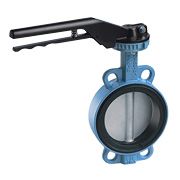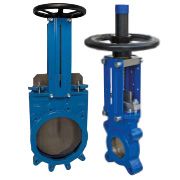Wafer dampers
The main task of the dampers is to regulate and cut off the flow of a given substance. For this reason, they are used in pipelines. A damper is a must in any system that filters drinking or sea water, wastewater or industrial fluids. The most popular type of this element are wafer dampers, although there are many more of them.
Butterfly Valves - Are They Different From Butterfly Valves?
The butterfly valve is the same part of the pipeline structure as the butterfly valve. A butterfly valve is a name that comes from the characteristic design of the valve. All the elements that make up this element are placed in a cylindrical body - its use enables the operation of the mechanism. The size of the cylinder determines the diameter of the valve, which should be given special attention before purchasing the device. Inside the body there is a disk - it is responsible for cutting off the flow of fluids and the shaft connected to it. The shaft is connected on one side to the bearing and on the other side to an actuator or control system which enables the entire valve to be operated. A manual mechanism is also often used in place of the actuator. For large butterfly valves, it most often takes the form of a worm gear.
The elements of the valve create a characteristic shape, somewhat reminiscent of a butterfly, hence the origin of the colloquial name. It is widely used - in stores you can often find throttles described as butterfly valves.
The disc rotates on a shaft around its axis. In order to block the flow of fluids, it is sufficient that it is placed perpendicular to the flowing liquid. This simple mechanism completely inhibits the movement of fluids. In contrast, full opening of the valve is ninety degrees in relation to the pipe. The butterfly valve mechanism is therefore often also referred to as a flap valve, as it is the flap that enables the flow of fluids to be controlled.
Throttle - how to choose the one that best suits our needs?
Butterfly valves, or throttles, are structurally different. The very structure and mechanism of operation of the valves is the same in all cases, but the differences can be seen in the way the valves are connected to the pipe. For this reason, there are some types of them, such as:
- flanged damper, which is attached to the pipe with flanges,
- WAFER type inter-wafer, ring-type damper, mounted between two flanges,
- wafer throttle with lugs, fastened with bolts, not flanges. The valve is equipped with threaded ears that allow the valve to be attached to the pipe flanges with bolts separate for each flange. This type of damper is called LUG.
We also divide throttles according to the location of the disk. Despite the slight design differences, when the disk space is moved, the principle of operation of the throttle remains the same. On the other hand, the position of the disk is changed in some models of valves in order to obtain even greater tightness of the mechanism and make them reliable. However, the most common are the previously described centric designs - the shaft runs straight through the center of the disc. Other solutions are:
- a double-eccentric structure, in which the shaft is shifted - is located behind the disc, and additionally it is not in the place of the diameter of the disc, but its chord. This means that the position of the shaft compared to the centric structure is shifted in two planes. Both in relation to the cross-section of the pipe and in relation to the direction of liquid flow,
- a triple eccentric structure in which the shaft is displaced not only with respect to the flow direction of the fluids and the cross-section of the tube, but also relative to the shear axis of the disc. This means that the axis of the sealing surface is shifted.
When choosing the best damper, we should focus primarily on parameters such as the diameter of the flap valve and the material from which the disc and its seals are made. In this context, it is worth paying attention to the type and pressure of the liquid or gas that will pass through the butterfly valve. The operating temperature is also an important aspect when choosing. Another flap valve is used in cold water supply systems, and another - in systems through which hot diesel fuel flows. It is also a good idea to take the quality of the seals into account when looking for the best valve to match the needs of your particular piping system. This valve component is the fastest to destroy, which can lead to leakage, especially with frequent work cycles. For this reason, models with the possibility of replacing the disc seal are recommended. As a result, the mechanism can perform its function properly over a long period of time.
Butterfly valve - where is it used? Advantages and disadvantages of butterfly valves.
The throttle is a mechanism whose use has many advantages. First of all, butterfly valves are characterized by a light structure and easy installation. Due to the availability of several options on the market, such as flanged butterfly valves, wafer ring butterfly valves and bolted wafer butterfly valves, the best valves can be tailored to the needs of your specific piping system. Importantly, the mechanism of these valves is very simple, and thus - usually failure-free. Due to the light and solid structure and failure-free operation, this structural element does not generate large costs related to transport, assembly and operation of the dampers.
Another advantage of this type of solutions is their versatility. An inter-wafer butterfly valve can be used even on very short pipe lengths. These types of elements are used in both horizontal, vertical and inclined pipeline systems. The versatility of dampers is also due to the fact that they can cope well with a wide range of temperatures and pressures of liquids. For this reason, they can be installed in various types of systems, both those conducting water, diesel oils and sewage. Due to this versatility, the dampers can be used in many industries, including the fuel, metallurgical, construction, chemical and food industries.
Butterfly valves are primarily found in heating, pneumatic and plumbing installations. Such a wide application of mechanisms in the type of butterfly valves is possible due to the fact that they are produced in many sizes. We can find small butterfly valves used in narrow pipes as well as industrial butterfly valves used in pipeline systems characterized by pipes with a large diameter.
The reason for such widespread use of these types of mechanisms in industry is also the fact that they generate a low pressure drop when shutting off the flow. The flap valve does not produce much pressure change, which is an advantage over most fluids. However, this state of affairs can also have negative consequences. Wafer and flanged dampers may entail the risk of cavitation, i.e. rapid transformation of liquid into gas under the influence of too low pressure. Operation of the flap valve in conditions caused by cavitation can cause leakage problems and, as a result, failure of the piping system.
An equally dangerous process for pipeline systems is the possibility of choked flow. This name is used to describe a phenomenon where the force present in the mechanism is used to overcome the friction force. For this reason, it is worth controlling the flow values and pressure drops generated by the operation of the flap valve. This allows you to react quickly enough to the negative effects of the cavitation process or choked flow. However, you do not have to worry about the use of this type of valve. Due to their specificity, butterfly valves are very well suited to work in systems with significant differences in pressure and flow rates.
It is worth noting that the inter-flange check valve, i.e. the disc used in inter-flange dampers, is susceptible to disturbances in the flow of liquid or gas that is to be restricted. Fluid turbulence may be a source of irregularities in the operation of the interflange check valve. For this reason, the butterfly valve should not be installed too close to the pump or other vibration source, which should be considered.
Another disadvantage of dampers is the problem with cleaning the pipe on which the disc is placed. Due to the design of the butterfly valve, removing impurities from this element is not easy. Moreover, this is almost impossible with small size dampers.
Despite these inconveniences, wafer butterfly valves are considered to be one of the best valves on the market. Their popularity is mainly due to the fact that they are universal, easy to install and light.
Pneumatic dampers - how to choose the best one?
Pneumatic dampers are one of the possible options when selecting a damper. In this case, the division concerns the drive. We distinguish between electric and pneumatic dampers. The first type is selected when an electric actuator is used, while the second type - when a damper for a pneumatic actuator should be selected.
Today, pneumatic actuators are still very common, but in the coming years, the use of electric actuators can be expected more and more. This is because pneumatic cylinders are not fuel efficient. Their operation is based on the production and transmission of compressed air. This process requires a lot of energy. For this reason, the industry is increasingly switching to the use of more ecological and economical electric actuators. If you intend to use this type of mechanism, you should pay special attention to the type of voltage to which the device is to be powered and the individual specification of the drive accessories before purchasing.
However, when deciding on the currently most popular form of a pneumatic damper, other elements of the technical specification of the mechanism should be checked. Before selecting the best air damper, it is worth checking several important aspects of this element's operation, such as its supply pressure, spring range, and actuator mode. It is also important to choose the right damper for the size of the actuator, which in turn depends on the type of fluid or gas that will be guided through the valve and the type and size of the damper. By checking these types of parameters, it is much easier to choose the right element for a given pipeline system.
Interestingly, air dampers are often used in exhaust systems as they allow you to control its volume. In this case, the mechanism is installed after the catalyst.
It is worth noting that wafer dampers are a very popular and good solution that is used as valves that cut off the flow of liquid or other medium. This is confirmed by the widespread use of this type of valves in industry (including chemical and hydraulic). Butterfly valves are appreciated primarily due to their versatility, durability, low weight and simple design. Due to the fact that they are a frequent choice of many professionals, a wide range of versions of this type of valves is available on the market.
The damper can be both a small element mounted in a narrow pipe, and a large liquid filtering mechanism on an industrial scale. It is also worth paying attention to the differences in assembly, which are the source of the division of these mechanisms into flanged dampers, ring-shaped inter-flanged dampers and those with lugs that are mounted with screws. The possibility of choosing different variants increases the versatility of this type of mechanisms.



